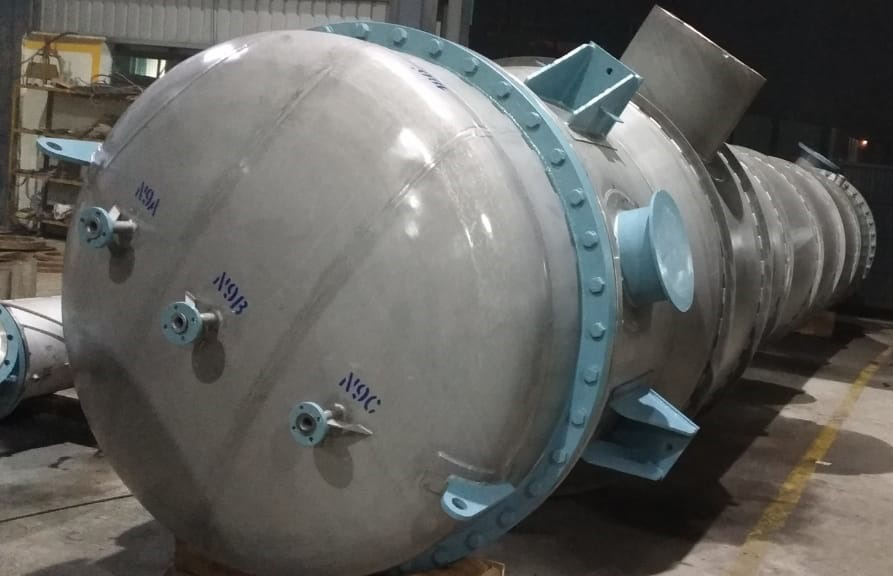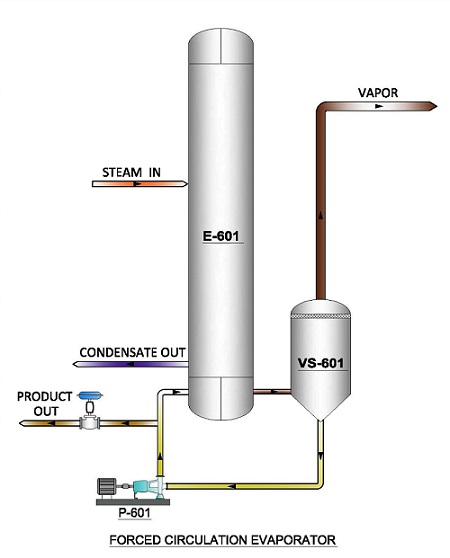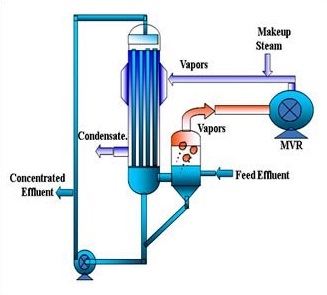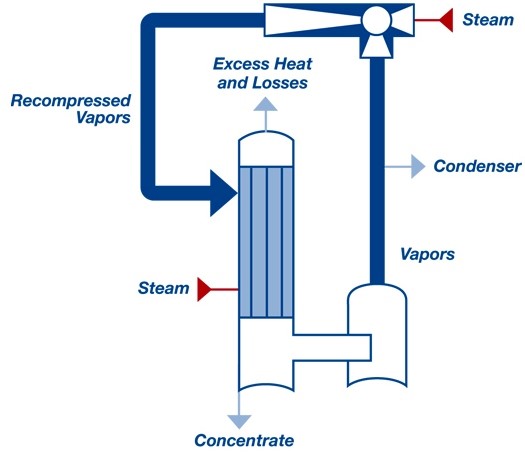Evaporation Plants
Evaporation is a type of vaporization of a liquid that occurs from the surface of a liquid into a gaseous phase that is not saturated with the evaporating substance. A great variety of evaporator designs are developed for specialize applications, these can be grouped into following basic types.

Evaporation Systems
- Falling Film Evaporation
- Rising Film Evaporation
- Forced Circulation Evaporation
- Thermal & Mechanical Vapor Re-compressor (TVR & MVR)
Falling Film Evaporation
Principle of Operation:
- The liquid to be concentrated is fed to the top of the heating tubes and is distributed evenly over distributor plate & flows down inside tube walls as a thin film.
- The liquid film starts boiling due to the external heating of the heating tubes and is partially evaporated. The downward flow, caused initially by gravity, is enhanced by the parallel, downward flow of the vapor formed.
- Residual film liquid and vapour is separated in vapor liquid separator (VLS).
Advantages:
![]() High Heat Transfer Coefficients
High Heat Transfer Coefficients
![]() Low Pressure Drop
Low Pressure Drop
![]() Suitable For Operation Under Full Vacuum
Suitable For Operation Under Full Vacuum
![]() High Evaporation Ratio
High Evaporation Ratio
![]() Low Susceptibility For Fouling
Low Susceptibility For Fouling
Applications:
![]() Spent Wash Distillery
Spent Wash Distillery
![]() Corn Steep Liquor
Corn Steep Liquor
![]() Waste water treatment
Waste water treatment
![]() Starch derivatives (LG, Malto-dextrins, Sorbitol, Dextrose
Starch derivatives (LG, Malto-dextrins, Sorbitol, Dextrose
monohydrate (DMH)
Rising Film Evaporation
Principle of Operation:
- In rising film evaporator liquid being evaporated is fed from the bottom into long tubes and heated with steam condensing on the outside of the tube from the shell side.
- This is to produce steam and vapour within the tube bringing liquid inside to a boil.
- The vapour produced then presses the liquid against the walls of the tubes and causes the ascending force of this liquid.
- As more vapours are formed, the centre of the tube will have a higher velocity which forces the remaining liquid against the tube wall forming a thin film which moves upwards.
Advantages:
![]() Low Residence Time
Low Residence Time
![]() High Heat Transfer Coefficient
High Heat Transfer Coefficient
![]() High Evaporation Ratio
High Evaporation Ratio
Applications:
![]() Juice Concentration & Food Processing
Juice Concentration & Food Processing
![]() Production Of Polymers
Production Of Polymers
![]() Thermal Desalination
Thermal Desalination
![]() Pharmaceuticals
Pharmaceuticals
![]() Solvent Recovery
Solvent Recovery
![]() Waste Water & Effluent Treatment
Waste Water & Effluent Treatment
Forced Circulation Evaporation
Principle of Operation:
- Liquid is circulated at high flow rate through heat exchanger, boiling being prevented within the unit by virtue of hydrostatic head maintained above top tube plate.
- As liquid enters separator where absolute pressure is slightly less than in tube bundles, liquid flashes to form vapors.
- Vapors are then passed to next effect and liquid is kept in continuous circulation. Once desired concentration is achieved product is taken out from final effect.
- Steam or vapors are used as heating media in forced circulation evaporation.
- To maintain a good heat transfer within the heat exchanger it is necessary to have a high recirculation flow rate.
- Calendria can be arranged either horizontally or vertically depending on the specific requirements in each case.
Advantages:
![]() Fouling is minimized due to high liquid velocities.
Fouling is minimized due to high liquid velocities.
![]() Optimized Heat Transfer
Optimized Heat Transfer
Applications:
![]() Spent Wash Distillery
Spent Wash Distillery
![]() Corn Steep Liquor
Corn Steep Liquor
![]() Liquids With a high tendency for fouling.
Liquids With a high tendency for fouling.
![]() Highly Viscous Liquids.
Highly Viscous Liquids.
![]() Waste Water Treatment
Waste Water Treatment

Thermal & Mechanical vapor re-compressor (TVR & MVR)
Thermal separation processes like evaporation is an energy intensive process. During continuous up-gradation in systems to make it more energy efficient, led it to multiple-effect plants, then to thermal vapour recompression and mechanical vapour recompression systems.
In each case, the decision on whether a vapour recompression system or Mechanical vapour recompression should be installed, must be made on the basis of an efficiency study.
A. Mechanical vapor recompressor (MVR):
- In MVR all the process vapours leaving the evaporator are recompressed to the pressure of the corresponding heating steam pressure/temperature used to heat the evaporator.
- The amounts of heat to be dissipated are considerably reduced, with the evaporator itself re-utilising the energy normally dissipated through the condenser cooling water.
- The energy required to drive the compressor is only the energy difference between the process vapor and the recompressed vapours, making such system energy efficient.
- Depending on the operating conditions of the plant, a small quantity of additional steam or the condensation of a small quantity of excess vapour may be required to maintain the overall evaporator heat balance and to ensure stable operating conditions.
- Low pressure steam will be required for preheating when starting up the process.
- The compressor can be either positive-displacement type (lobes or screw) or centrifugal type with one or several stages of compression, or fans. Due to their simplicity and maintenance friendly design, centrifugal fans are often used.

Advantages:
- Most energy efficient evaporation technology (n-effect)
- Almost no steam and cooling water consumption (boiler and cooling tower cost reduction)
- Suitable for moderate boiling elevation products
B. Thermo vapor recompressor (TVR):
- Wherever steam is available at a high pressure as compared with the pressure needed in the evaporator, the use of a thermal vapour recompressor gives the same steam/energy saving as an additional evaporation effect.
- During thermal vapour recompression, a fraction of the process vapor from the boiling chamber is recycled and recompressed in a steam jet ejector with high pressure live steam, called motive steam, to a higher pressure and temperature as required for the heating of the evaporator.
- As we recycle of process vapour, the amount of live steam required for heating is lower and flow of process vapour going to the subsequent effect or condenser is therefore reduced, decreasing the cooling water demand.

Advantages:
![]() Most energy efficient evaporation technology (n-effect)
Most energy efficient evaporation technology (n-effect)
![]() Almost no steam and cooling water consumption (boiler
Almost no steam and cooling water consumption (boiler
and cooling tower cost reduction)
![]() Suitable for moderate boiling elevation products
Suitable for moderate boiling elevation products
Applications:
![]() Food and Beverages industry (evaporation of milk, whey
Food and Beverages industry (evaporation of milk, whey
and sugar solutions)
![]() Chemical industry (evaporation of aqueous solutions)
Chemical industry (evaporation of aqueous solutions)
![]() Salt Works industry (evaporation of saline solutions)
Salt Works industry (evaporation of saline solutions)
![]() ZLD (concentration of waste water)
ZLD (concentration of waste water)
